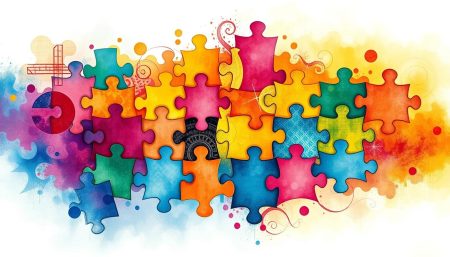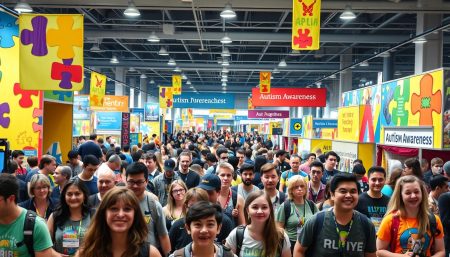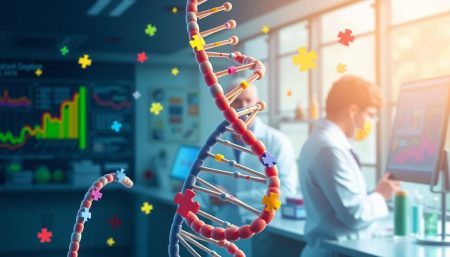Autism spectrum disorder includes many neurodevelopmental conditions. Pervasive Developmental Disorder-Not-Other Specified (PDD-NOS) is a special and less known part of it. It has its own set of challenges that can differ a lot from person to person.
People with PDD-NOS often show fewer symptoms than those with classical autism. This makes it harder to understand and support them.
Misconceptions about PDD-NOS make it tough for those dealing with it. We need to learn more about it. This will help us provide better support and resources.
As we learn more about PDD-NOS, we see how it affects families and communities. It’s important to talk more about it and support those affected.
PDD-NOS has a big impact, just like the autism spectrum itself. This introduction aims to highlight PDD-NOS’s uniqueness. It also wants to make sure we understand it well within the world of developmental disorders.
What Is Autism Spectrum Disorder PDD-NOS?
Pervasive Developmental Disorder Not Specified (PDD-NOS) is a part of autism spectrum disorders. It has symptoms that don’t fit into classic autism or Asperger’s Syndrome. This makes PDD-NOS clarification key to understanding this complex condition.
The Broad Spectrum of Autism Diagnosis
The world of autism diagnosis is wide and varied. PDD-NOS is in a special spot. It’s for those with autism-like symptoms but not enough to be called other specific disorders. Each person’s symptoms and how strong they are are very important.
Clarifying PDD-NOS Within the Autism Spectrum
PDD-NOS is a milder form of autism. It was made to help those who don’t fit into other autism categories. PDD-NOS clarification helps tailor treatments and support better. This ensures everyone gets the right help they need.
Differences Between PDD-NOS and Other Forms of ASD
The main autism spectrum differences between PDD-NOS and other autism types are in symptom severity and type. People with classic autism often have more serious communication problems and repetitive actions. Those with PDD-NOS have milder symptoms that don’t fully match typical autism.
It’s vital to understand these differences for proper support and care. This shows the importance of recognizing and valuing the autism spectrum differences in each diagnosis. As diagnosis criteria change, knowing these differences helps in supporting those with PDD-NOS.
Early Signs of PDD-NOS in Children
Spotting the early signs of autism, like PDD-NOS, is key for parents and caregivers. Knowing these signs early can lead to timely help. This is vital for managing the condition. We will look at developmental delays and emotional signs in ASD that might show PDD-NOS in young kids.
Spotting Developmental Delays
Children with developmental delays might have PDD-NOS. These delays show up in social skills, communication, and behavior. It’s important to watch how a child meets and moves through milestones compared to their age.
- Lack of or delayed speech development
- Minimal social interactions, such as making eye contact or responding to name
- Difficulty in playing socially with other children
Recognizing Social and Emotional Indicators
The emotional signs of ASD are wide-ranging and key to understanding the disorder’s impact. Kids with PDD-NOS might react differently than others. Spotting these signs early helps in creating support systems for the child.
- Sensitivity to sensory stimuli such as sound or touch
- Difficulty in adapting to routine changes or unfamiliar situations
- Exhibiting repetitive behaviors or fixations on specific objects
| Developmental Area | Typical Development | Common Signs in PDD-NOS |
|---|---|---|
| Communication Skills | Simple words by 15 months, phrases by 2 years | Delays in speech, may not combine words |
| Social Interaction | Shared interest, smiles, eye contact by 6 months | Limited or absent eye contact, indifferent to social engagements |
| Adaptability to Change | Generally adaptable, notices but recovers quickly from changes | Significant distress at changes, preference for routine |
Diagnosing Autism Spectrum Disorder PDD-NOS
Diagnosing autism, like PDD-NOS, is a detailed process. It’s key to finding the right support and treatments for each person. This method shows how complex and unique autism spectrum disorders are.
The diagnostic journey starts with parents noticing delays or unusual behaviors in their child. These early signs are important. They lead to the first PDD-NOS assessment, often by a pediatrician who notices something different from usual growth.
Then, specialists like developmental pediatricians or child psychologists get involved. They are experts in evaluating developmental disorders. Diagnosing PDD-NOS can be tricky because symptoms are not always obvious or typical.
- Developmental Monitoring: Watching a child’s growth to spot any developmental issues.
- Screening: Using specific tests to check for developmental disorders during health checkups.
- Comprehensive Diagnostic Evaluation: A detailed review of the child’s behavior and development. This includes medical tests and family interviews to understand the child’s background.
Specialists work together to understand a child’s strengths and challenges. Teachers and caregivers offer important insights. They share how the child interacts socially, learns, and adapts to different situations. This information helps doctors make an accurate diagnosis and suggest the right treatments.
It’s clear that diagnosing autism spectrum disorder PDD-NOS is complex. It requires a personalized approach for each case. This shows the importance of a detailed and tailored evaluation process.
Understanding the Causes of Autism Spectrum Disorders
For decades, scientists have been trying to figure out what causes autism. This complex condition is shaped by many things, like genes and the environment. Studies show that genes play a big role in autism, affecting how our brains grow.
Autism is a complex issue, and scientists are working hard to understand it. They’re looking at both genetic and environmental factors. This includes how a child’s early life might affect their chances of developing autism.
- Genetic research: This is a key area in autism studies. It looks at how genes, both inherited and new, impact brain development.
- Neurological studies: These studies examine how autistic brains work differently. They suggest that brain differences are a big part of autism.
- Environmental factors: Researchers are also looking into how things like toxins or viruses might link to autism.
By studying both genetic and environmental factors, scientists are getting closer to helping people with autism. They’re working towards better treatments, support, and maybe even ways to prevent autism in the future.
Communication Strategies for Autism
Good communication is key for a better life for people with autism, like those with PDD-NOS. Creating strong communication plans helps build talking skills. It also uses tools like augmentative communication to make talking clearer.
Enhancing Verbal Interaction Skills
Regular speech therapy and home exercises can boost talking skills for those with autism. Speech therapists use games to teach social talking. They focus on taking turns and understanding what others say.
Using Alternative and Augmentative Communication
For those who can’t talk much, special communication tools are very helpful. Devices or apps that speak for you are common. The Picture Exchange Communication System (PECS) uses pictures to help people communicate.
Improving Non-Verbal Communication Techniques
Learning non-verbal signs is also important. Teaching gestures and body language helps people with autism talk better. Therapy uses fun activities to teach these skills.

Behavioral Therapy for Autism
Behavioral therapy for autism, like Applied Behavior Analysis (ABA), is key for those with Autism Spectrum Disorder PDD-NOS. It aims to boost good behaviors and cut down on harmful ones. This helps with learning and growing.
Applying ABA in Therapy Sessions
Applied Behavior Analysis (ABA) looks at how environment affects behavior. It then uses methods to improve certain behaviors. ABA is known for making helpful behaviors more common and harmful ones less so in therapy.
Behavioral Interventions for Home and School
It’s important to use behavioral interventions at home and school. This ensures skills learned in therapy stick in everyday life. Here’s a look at how to apply these interventions in different places:
| Environment | Intervention | Goal |
|---|---|---|
| Home | Structured Learning Time | To integrate educational activities that encourage positive behavior and skill advancement. |
| School | Peer-mediated Strategies | To improve social interactions and increase peer engagement through facilitated activities. |
| Home & School | Consistency Management | To ensure that behavioral expectations are consistent across different settings. |
In short, using ABA and other interventions in home and school settings helps kids with autism a lot. It helps them use skills in different parts of their life. It’s vital for therapists, teachers, and families to work together to make sure interventions fit each child’s needs.
Developmental Disorders and Comorbid Conditions
People with PDD-NOS often face a range of associated developmental disorders and comorbid conditions. These can greatly affect their daily lives and treatment plans. Common conditions include ADHD, anxiety disorders, and sensory processing issues. Each one brings its own set of PDD-NOS challenges.
ADHD is a common condition found with PDD-NOS. It shares symptoms like trouble focusing and being too active. Anxiety disorders can make it harder to interact socially and communicate. Sensory processing issues affect how one perceives and reacts to the world around them.
- Attention Deficit Hyperactivity Disorder (ADHD): Increases impulsivity and attention challenges.
- Anxiety Disorders: Heightens social and emotional difficulties.
- Sensory Processing Issues: Alters interaction with the sensory aspects of the environment.
Impact on Treatment: Treating these comorbid conditions requires a team effort. This team uses special behavioral therapies, support, and sometimes medicine. By tackling all symptoms, care becomes more complete, improving life and growth for the individual.
Diagnosing PDD-NOS alone doesn’t capture the full picture. It’s vital to understand the complex mix of challenges involved. This knowledge helps care providers, educators, and families create effective, caring plans for those with PDD-NOS and related conditions.
Family Support and Resources
The journey for families with autism, like PDD-NOS, gets easier with the right family support for autism. It’s key to understand both the emotional and practical sides of support. This helps create a caring space for everyone in the family.
Navigating Emotional and Financial Challenges
Families face big emotional challenges after an autism diagnosis. The first steps can be tough, filled with uncertainty and stress. It’s important to find ways to deal with these feelings.
Connecting with autism support resources can help a lot. They offer relief and useful tips. The cost of therapies and education can also be a big worry. Looking into subsidies, grants, and fundraising is a smart move to handle these costs.
Connecting with Support Groups and Communities
Creating a network through local and online autism support resources is very helpful. Support groups share experiences and advice. They also offer emotional support, making the journey less lonely.
Community centers and online forums are great for both socializing and learning. They help families stay updated and connected.
| Resource | Description | Accessibility |
|---|---|---|
| Local Support Groups | Regular meetings for sharing experiences and advice | Varies by location |
| Online Forums | 24/7 access to a community and resource sharing | Global access |
| Educational Workshops | Skills training and professional guidance | Often free or low-cost |
Using these family support for autism networks and resources makes life better for those with autism. It ensures families don’t face this journey alone.
Autism Spectrum Disorder PDD-NOS and Education
Education for kids with Autism Spectrum Disorder, like PDD-NOS, uses special strategies and services. These help meet their learning needs, promote inclusion, and help them reach their full ability.
Individualized Education Plans for PDD-NOS
Individualized Education Plans (IEPs) are made just for kids with PDD-NOS. Teachers, therapists, and parents work together to create a learning plan that fits each student. IEPs set goals, teaching methods, and support services based on what each student can do and needs to learn.
Inclusion Strategies in Mainstream Classrooms
In mainstream classrooms, inclusion strategies help create a supportive learning space for all. This includes adjusting the curriculum, using peer support, and training teachers. It helps students with PDD-NOS and makes learning better for everyone, promoting social understanding and inclusion.
Special Education Services and Supports
Special education services offer extra help for kids with PDD-NOS. This can include speech, occupational, physical therapy, and more. These services can be in regular classrooms or special settings. The goal is to improve their education and life quality.
Table: Comparison of Inclusion Techniques and Special Education Services
| Inclusion Techniques | Special Education Services |
|---|---|
| Peer-mediated instruction | Speech therapy |
| Differentiated instruction | Occupational therapy |
| Visual supports in classrooms | Behavioral therapy |
| Teacher’s aides and support staff | Resource rooms |
Integrating Social Skills Training for ASD
Helping people with Autism Spectrum Disorder (ASD) is key. Social skills training for ASD includes many activities. These help them understand and interact better. Role-playing activities and group work are very important for learning social skills.
Role-Playing and Social Interaction Activities
Role-playing is a big part of social skills training for ASD. It lets people practice real-life situations in a safe way. They can try out different responses and feelings in a supportive setting.
This kind of learning is vital for building confidence. It also helps improve how they understand social situations.
Fostering Peer Relationships through Group Work
Group work is also very important. It helps people with ASD make friends and work together. They learn from others and get better at reading social cues.
These interactions help them form strong relationships. They also get better at dealing with social challenges.
- Role-playing sessions to handle specific social situations
- Group discussions to enhance perspective-taking abilities
- Team-building exercises to promote cooperation and empathy
By adding these activities to daily therapy, people with ASD can see big improvements. They get better at social interactions and enjoy a better life. This helps them grow and makes society more understanding and inclusive.
Sensory Processing in Autism
Looking into sensory processing in autism shows how people see and feel things differently. These differences can really impact daily life and happiness. So, making places sensory-friendly is very important.
Understanding Sensory Sensitivities and Needs
People with autism might feel things too strongly or not at all. Some might hear sounds that seem too loud, while others might miss them. Knowing these differences helps us create better support in different places.
Creating Sensory-friendly Environments
Making spaces that fit these needs can really help. Whether it’s at home, school, or in public, these places should be calm. They help reduce stress and make people feel better.
| Environment | Features | Benefits |
|---|---|---|
| Home | Adjustable lighting, noise-control materials, personalized spaces | Enhances comfort, reduces stress |
| School | Sensory corners, visual aids, structured classroom layouts | Supports learning, encourages participation |
| Public Spaces | Quiet zones, informational signage, sensory-adaptive events | Increases accessibility, promotes inclusivity |
By designing with care and making thoughtful changes, we can make places better for everyone. This focus on sensory-friendly environments helps manage sensory sensitivities. It also supports the growth and inclusion of those with sensory processing in autism.
Transitioning to Adulthood with PDD-NOS
Transitioning to adulthood with Pervasive Developmental Disorder-Not Specified (PDD-NOS) is both challenging and rewarding. This part of the article focuses on the important steps for those with PDD-NOS. It’s about helping them gain independence in PDD-NOS and plan for a fulfilling life.
As people move from being teenagers to adults, they need a special life plan for ASD. This plan should be detailed, practical, and flexible. It should help them reach their personal and professional goals. Important areas like work, education, social life, and daily skills are key parts of this plan. Here are some strategies:
- Vocational Training: Programs that match their strengths and interests help them find jobs.
- Educational Opportunities: Special courses or college can improve their skills and social life.
- Building Social Connections: Programs that help them make friends are important for a well-rounded life.
- Daily Living Skills: Learning to manage money and take care of themselves is vital for independence.
A supportive community is essential for independence in PDD-NOS. Family, friends, and caretakers play a big role. Also, having access to special resources like therapy, mentors, and jobs that welcome them can greatly improve their life.
In summary, achieving independence in PDD-NOS requires teamwork and specific strategies. By focusing on life planning for ASD, we can help those with PDD-NOS live happy and independent lives.
Advancements in Childhood Interventions
The field of autism therapy is changing fast. New advancements in autism therapy and emerging treatments bring hope. They also show how technology in ASD interventions can help.
Emerging Therapies and Treatments
New biotechnologies and medicines are being studied. These emerging treatments aim to fix the genetic and brain issues in ASD. This is a big change from old treatments.
Understanding autism better has led to new therapies. These therapies are made for each child’s needs. This means better and more personal care. For more on mental health, see here.
Technology-aided Learning and Development Tools
New tech tools help kids learn and grow. Virtual reality (VR) lets kids practice social skills in a safe space. It’s less overwhelming than the real world.
Mobile apps are also helping. They make learning fun through games. Kids get rewards for reaching goals, which is key in ASD therapy.
| Technology Type | Application in ASD Interventions | Notable Benefits |
|---|---|---|
| Virtual Reality (VR) | Simulation of social scenarios | Enhanced learning of behavioral cues |
| Assistive Apps | Cognitive and language skills development | Interactive learning; Performance tracking |
| Wearable Devices | Monitoring physiological responses | Real-time data for better personalization of therapy |
Using these tech tools in therapy helps kids and their caregivers. It also helps teachers do their job better.
Early Intervention Programs for Autism
Early intervention programs for autism can greatly improve treatment results. These programs focus on early diagnosis and tailor treatments to each child. They also give families the support and knowledge they need.
The Importance of Early Diagnosis and Treatment
Understanding the early diagnosis benefits is key for autism. Early detection leads to interventions that fit each child’s needs. This approach can lead to faster progress and less need for intense treatments later.
Tailoring Early Intervention to Individual Needs
Personalized treatment in early autism programs starts with a deep look at the child’s abilities and challenges. Tailored strategies help address specific areas of development. This makes the program more effective for the child.
| Intervention Type | Focus Area | Expected Outcomes |
|---|---|---|
| Behavioral Therapy | Social Skills | Improved peer interaction |
| Occupational Therapy | Sensory and Motor Skills | Enhanced daily functioning |
| Speech Therapy | Communication Skills | Increased verbal ability |
Diet and Nutrition in Managing PDD-NOS
Managing PDD-NOS (Pervasive Developmental Disorder Not Specified) needs a whole approach. Nutrition for PDD-NOS management is key. Studies and caregiver stories show that certain dietary interventions for ASD can help a lot.

The idea of an autism diet is to change what foods you eat. It might help with autism symptoms. Some diets are gluten-free, casein-free (GFCF), and add more vitamins and nutrients.
- Gluten-Free and Casein-Free Diet: Some think gluten and casein, found in wheat and dairy, can cause problems. Taking them out might help with behavior.
- Omega-3 Fatty Acids: These are good for the brain. Eating foods with Omega-3s, like fish oils, might help with thinking and behavior.
- Vitamins and Minerals: More vitamins and minerals, like Vitamin D, magnesium, and zinc, can help the brain and reduce symptoms.
Many people think these diets help, but the science is not clear. How someone with autism reacts to dietary interventions for ASD can be different. Always talk to a doctor or dietitian before changing your diet.
Adding the right autism diets and nutrition plans is important for managing PDD-NOS. Caregivers should watch how these diets work and make changes as needed. This helps keep the person healthy and happy.
The Importance of Community Awareness and Acceptance
Exploring Autism Spectrum Disorder, like Pervasive Developmental Disorder-Not-Other Specified (PDD-NOS), shows us how key community awareness of PDD-NOS is. It helps create a caring and supportive place for those affected. Understanding the challenges and strengths of autism is vital for a society that values everyone.
By focusing on autism acceptance, we build a foundation for inclusion. This lets people with autism make a difference and succeed.
Campaigns have helped change how society views autism. They’ve shown the diversity and unique views of people with autism, promoting autism understanding. This has led to more inclusive places like schools, workplaces, and social areas. It has helped clear up wrong ideas and built networks that welcome those with PDD-NOS.
Wider community awareness does more than help individuals; it makes our society better. Schools that meet different learning needs, employers who see the talents of autistic people, and social programs that bring people together all help. This focus on understanding and acceptance improves lives and strengthens community ties. It leads to a more caring, creative, and united world.
FAQ
Q: What is Autism Spectrum Disorder PDD-NOS?
A: Autism Spectrum Disorder PDD-NOS, or Pervasive Developmental Disorder Not Specified, is part of the autism spectrum. It shows developmental delays, social and communication challenges, and repetitive behaviors. It’s for those who don’t fully meet autism or Asperger’s criteria but show autistic behaviors.
Q: How does PDD-NOS differ from other forms of ASD?
A: PDD-NOS is diagnosed when autism or Asperger’s criteria aren’t fully met. People with PDD-NOS might have fewer symptoms than those with classical autism. The symptoms’ severity and mix can vary, making PDD-NOS a complex diagnosis.
Q: What are the early signs of PDD-NOS in children?
A: Early signs include speech delays, social interaction challenges, and repetitive behaviors. Children might show little interest in play or peers. Parents notice their child’s development is different from typical kids.
Q: What is the diagnostic process for PDD-NOS?
A: Diagnosing PDD-NOS involves a team of healthcare professionals. They assess the child’s development, behavior, and social and communication skills. Information from parents, teachers, and caregivers is key for an accurate diagnosis.
Q: What are the causes of Autism Spectrum Disorders including PDD-NOS?
A: The causes of Autism Spectrum Disorders, including PDD-NOS, are not fully known. Research points to genetic, neurological, and environmental factors. Studies aim to understand and prevent these conditions.
Q: What communication strategies are effective for children with PDD-NOS?
A: Effective strategies include speech therapy and using alternative communication systems. Teaching gestures and recognizing body language cues also helps. These methods improve communication skills.
Q: How can behavioral therapy be applied to children with autism, including PDD-NOS?
A: Behavioral therapy, like Applied Behavior Analysis (ABA), is effective for PDD-NOS. It teaches positive behaviors and reduces challenging ones. ABA is tailored to each child and used in various settings.
Q: What are some common comorbid conditions with PDD-NOS?
A: Common conditions include ADHD, anxiety disorders, sensory processing issues, and learning disabilities. Managing these conditions with PDD-NOS requires a holistic approach to treatment.
Q: What role do Individualized Education Plans (IEPs) play in the education of students with PDD-NOS?
A: IEPs are vital for students with PDD-NOS. They provide tailored goals and accommodations. IEPs ensure the child can access the curriculum and make educational progress.
Q: How can social skills be integrated into training for children with PDD-NOS?
A: Training includes role-playing, social stories, and group work. These activities teach social behaviors and help build friendships. They improve communication and understanding of social cues.
Q: What does sensory processing in autism entail?
A: Sensory processing in autism involves sensitivity to sounds, lights, textures, or tastes. Individuals with PDD-NOS may need help managing their sensory needs. This can involve creating sensory-friendly environments or using specific tools.
Q: What are the key considerations when transitioning to adulthood with PDD-NOS?
A: Transitioning to adulthood involves planning for education, vocational training, and social integration. It’s important to start early and access resources for a successful transition into adult life.
Q: What are the latest advancements in childhood interventions for Autism including PDD-NOS?
A: New therapies include neurofeedback and social skills training apps. Virtual reality is also used for therapy and education. These tools provide immersive experiences for skill development.
Q: Why are early intervention programs important for children with Autism Spectrum Disorder?
A: Early intervention programs are critical for positive changes in a child’s developing brain. They address developmental delays and foster essential skills in the early years of life.
Q: Can diet and nutrition play a role in managing PDD-NOS?
A: Proper nutrition is important for managing PDD-NOS symptoms and overall health. Some families see improvements with dietary changes like gluten-free or casein-free diets. Always consult healthcare professionals before making diet changes.
Q: How can community awareness and acceptance of PDD-NOS be improved?
A: Awareness and acceptance can be improved through education and inclusive practices. Advocacy, support, and celebrating diversity help create a more understanding society.


















